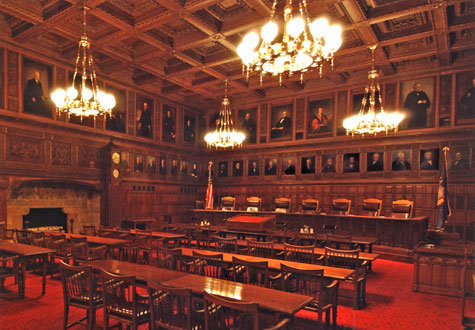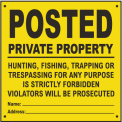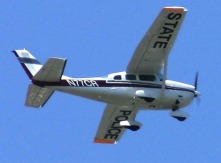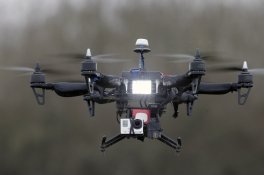Obligatory disclaimer: I am not a legal professional. The information, opinions, and analysis in this post and any others should not be taken as legal advice. I welcome any professional input; this would be greatly appreciated.
In Part I, we learned that in People v. Scott, 79 N.Y.2d,the State Appellate Court reversed the County Court’s ruling. By doing this, they were abandoning their own rulings in two prior cases, and also rejecting a prior U.S. Supreme Court ruling. (Oliver v United States (466 US 170). ) Rejecting a Supreme Court ruling is kind of a big deal.
So what happened? Why did the Appellate Court reject it? In Scott, the judges decided that the actual legal question they had to rule on was whether or not Oliver should be adopted as NY Law under under article 1, § 12 of the state constitution. The majority judges ruled  that Oliver literally interpreted the 4th Amendment to protect things and not people, so it could “not adequately protect fundamental constitutional rights”. Additionally, they noted that Oliver disregarded an earlier related Supreme Court case ruling (1967) and the ensuing body of case law based on it. They felt this was contradictory. Therefore, they would not adopt Oliver as state law. In their own words:
that Oliver literally interpreted the 4th Amendment to protect things and not people, so it could “not adequately protect fundamental constitutional rights”. Additionally, they noted that Oliver disregarded an earlier related Supreme Court case ruling (1967) and the ensuing body of case law based on it. They felt this was contradictory. Therefore, they would not adopt Oliver as state law. In their own words:
We believe that under the law of this State the citizens are entitled to more protection. A constitutional rule which permits State agents to invade private lands for no reason at all – without permission and in outright disregard to the owner’s efforts to maintain privacy by fencing or posting signs – is one that we cannot accept as adequately preserving fundamental rights of New York citizens.
And also:
There is nothing in People v Reynolds (supra) which inhibits our rejection of Oliver if we are persuaded that the proper safeguarding of fundamental constitutional rights requires that we do so (see, e.g., People v P.J. Video, supra, at 303-306).¹
To support this statement, section II of Scott cites numerous cases where the State Appellate Court partially or entirely rejected U.S. Supreme Court rulings. So there is

precedent for rejecting U.S. Supreme Court rulings when the Appellate Court believes these rulings do not provide enough protection under the state constitution. If state appellate courts can do this, than there exists a major gray area regarding the authority of state courts in the Federal justice system. I’m sure legal professionals are well aware of this, however I don’t think the public at large is aware.
So there you have it – the rest of the story. This has been a very simple summary of the issue. You should read through People v. Scott and the further reading below to get all the details.
My Armchair, Non-Professional Legal Q & A:
(Obligatory disclaimer: I am not a legal professional. The information, opinions, and analysis in this post and any others should not be taken as legal advice. I welcome any input from legal professionals.)
- If I post and/or fence in my open fields, can NY state law enforcement officers or their agents enter without a warrant?
 Nope. However, if they are nearby and see, hear, or smell something illegal, or witness someone doing something illegal on your property, they can act on it. I would assume they can use binoculars or a telescope. We get into degrees of intrusiveness here, and generally speaking, the less physically intrusive the surveillance is, the more permissible it becomes.
Nope. However, if they are nearby and see, hear, or smell something illegal, or witness someone doing something illegal on your property, they can act on it. I would assume they can use binoculars or a telescope. We get into degrees of intrusiveness here, and generally speaking, the less physically intrusive the surveillance is, the more permissible it becomes.
2. Can NY State law enforcement officers fly over my property and look at it?
 Yes. The standards for intrusiveness for manned aerial surveillance are different from ground searches. It is basically permissible in NY for law enforcement to fly overhead in open, navigable airspace and look at a property.
Yes. The standards for intrusiveness for manned aerial surveillance are different from ground searches. It is basically permissible in NY for law enforcement to fly overhead in open, navigable airspace and look at a property.
3. What about UAVs – Unmanned Aerial Vehicles (drones)?
Right now, law enforcement UAVs are not regulated in New York State. So my best guess is that law enforcement will use them to do surveillance and they will retain the data indefinitely until regulations are passed, or a court restricts their use.
So what is considered open, navigable airspace for drones? The air two feet above your head? Twenty feet? Fifty feet? The air outside your windows? Again, we’re talking  about degrees of intrusiveness, and to the best of my knowledge, the precise measurements are not yet determined. Bill A06713 is the only proposed state UAV law that I’m aware of, and it is pending in the State Assembly. It regulates the use of unmanned aerial vehicles by the state and political subdivisions. It was submitted in 2015 and referred to the Committee For Governmental Operations in January of 2016. No further action has been taken as of the date of this writing.
about degrees of intrusiveness, and to the best of my knowledge, the precise measurements are not yet determined. Bill A06713 is the only proposed state UAV law that I’m aware of, and it is pending in the State Assembly. It regulates the use of unmanned aerial vehicles by the state and political subdivisions. It was submitted in 2015 and referred to the Committee For Governmental Operations in January of 2016. No further action has been taken as of the date of this writing.
4. What about Federal Law Enforcement? Can they enter a posted and/or fenced property in NY State without a warrant?
It would seem so. Federal law enforcement operates under federal law, however I’m not sure how this is actually handled out in the field. How do state and federal law enforcement agencies coordinate when federal activity is at odds with state law? Perhaps a legal professional could weigh in.
Footnotes
¹You can read more about Reynolds, P.J. Video, and other supporting cases in section II of People v. Scott, 79 N.Y.2d 474.
Further Reading on the Subject…
Austin, Carolyn (2012) “New York Court of Appeals Declares an Open Field Posted with “No Trespassing” Signs Protected from Warrentless Searches and Seizures under the New York State Constitution,” St. John’s Law Review: Vol. 67: Iss. 2, Article 8. Available at: http://scholarship.law.stjohns.edu/lawreview/vol67/iss2/8
Sack, Kevin. “New York Court Voids Searches Allowed by U.S.” The New York Times, 3 Apr. 1992, http://www.nytimes.com/1992/04/03/nyregion/new-york-court-voids-searches-allowed-by-us.html.
